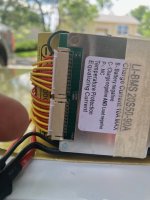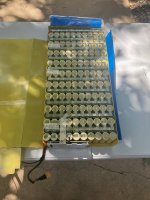Been playing with this project for far too long and my own negligence most likely caused this and at this point it's just learning. So building an ebike, have a 72v LiPo battery with BMS, battery was reading ~72v (maybe like 71v) last time I checked it but ya know life gets in the way so I didn't have it plugged into anything for 8-10 months then starting playing again.
At that time I did plug-in the charger to confirm it charged (saw voltage rise, charger went red LED) but since I wasn't ready to 'use' the battery with the motor yet I didn't leave it on charger so this battery was sat aside.
Now when I go test the battery with multimeter it reads 0v, nothing at all. If I plug-in charger, I see 83.9v on the output wires but the charger never goes into 'charging mode' and few seconds after unplugging charger the voltage goes back to 0. From what I gather I may have 'killed' my BMS which could mean cells are damaged so am trying to be careful but more just trying to understand all of what's going on here. Absolutely nothing on the battery has gotten hot/warm/etc when connected to the charger, it's like nothing at all is happening.
Is this normal behavior for a BMS that has died? It's almost like the charger voltage/power is just passing through the BMS but nothing is stored/charging in the batteries? I've also thought of maybe getting a different charger to see if that would be better but could also be a waste of money since this feels like a BMS/battery issue.
I do know that the true test here may be just opening up the battery pack and testing each cell, I just haven't moved to that step yet. More just trying to understand a bit before I move too fast/take things apart and I'm not opening a 72v battery pack lightly but either way here I want to learn from my mistakes.
At that time I did plug-in the charger to confirm it charged (saw voltage rise, charger went red LED) but since I wasn't ready to 'use' the battery with the motor yet I didn't leave it on charger so this battery was sat aside.
Now when I go test the battery with multimeter it reads 0v, nothing at all. If I plug-in charger, I see 83.9v on the output wires but the charger never goes into 'charging mode' and few seconds after unplugging charger the voltage goes back to 0. From what I gather I may have 'killed' my BMS which could mean cells are damaged so am trying to be careful but more just trying to understand all of what's going on here. Absolutely nothing on the battery has gotten hot/warm/etc when connected to the charger, it's like nothing at all is happening.
Is this normal behavior for a BMS that has died? It's almost like the charger voltage/power is just passing through the BMS but nothing is stored/charging in the batteries? I've also thought of maybe getting a different charger to see if that would be better but could also be a waste of money since this feels like a BMS/battery issue.
I do know that the true test here may be just opening up the battery pack and testing each cell, I just haven't moved to that step yet. More just trying to understand a bit before I move too fast/take things apart and I'm not opening a 72v battery pack lightly but either way here I want to learn from my mistakes.




